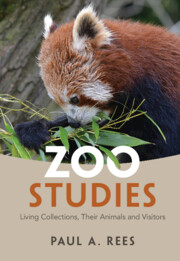Book contents
- Zoo Studies
- Zoo Studies
- Copyright page
- Dedication
- Contents
- Preface
- Acknowledgements
- Abbreviations
- 1 Zoos and Research
- 2 Defining Zoos, Their Culture and Visitors
- 3 Zoos and Education
- 4 Anthrozoology and Visitor Behaviour
- 5 Zoo Organisation and Regulation
- 6 Ethics, Zoos and Public Attitudes
- 7 The Contribution of Zoos to Zoology
- 8 Animals and Their Enclosures
- 9 Animal Welfare
- 10 Enrichment and Training
- 11 Conservation Breeding, Reproduction and Genetics
- 12 Restoration, Rehabilitation and In-Situ Conservation
- 13 Animal Nutrition and Conservation Medicine
- 14 The Past and Future of Zoos
- Bibliography
- References
- Subject Index
- Animal Species Index
11 - Conservation Breeding, Reproduction and Genetics
Published online by Cambridge University Press: 12 May 2023
- Zoo Studies
- Zoo Studies
- Copyright page
- Dedication
- Contents
- Preface
- Acknowledgements
- Abbreviations
- 1 Zoos and Research
- 2 Defining Zoos, Their Culture and Visitors
- 3 Zoos and Education
- 4 Anthrozoology and Visitor Behaviour
- 5 Zoo Organisation and Regulation
- 6 Ethics, Zoos and Public Attitudes
- 7 The Contribution of Zoos to Zoology
- 8 Animals and Their Enclosures
- 9 Animal Welfare
- 10 Enrichment and Training
- 11 Conservation Breeding, Reproduction and Genetics
- 12 Restoration, Rehabilitation and In-Situ Conservation
- 13 Animal Nutrition and Conservation Medicine
- 14 The Past and Future of Zoos
- Bibliography
- References
- Subject Index
- Animal Species Index
Summary
This chapter considers the efforts that zoos have made to establish cooperative breeding programmes to create insurance populations of threatened species in zoos, such as the establishment of international studbooks, the EAZA Ex-situ Programmes (EEPs) in Europe and the Species Survival Plan® (SSP) programmes in North America. To improve breeding in some species a number of assisted reproductive technologies have been developed, including artificial insemination, cloning and frozen zoos. In order to manage genetic diversity and prevent the effects of inbreeding, some animals may need to be culled or given contraception. Population growth in managed populations has been predicted by using computer simulations. Some species have recovered well in the wild without the need for ex-situ breeding programmes.
- Type
- Chapter
- Information
- Zoo StudiesLiving Collections, Their Animals and Visitors, pp. 262 - 293Publisher: Cambridge University PressPrint publication year: 2023

